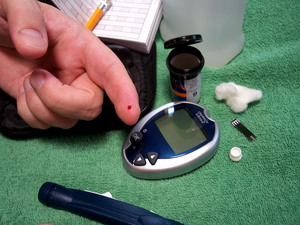If you have diabetes, you know it’s important to stay active to help reduce your blood sugar levels – but what type of exercise is best? According to a new study, the best exercise for diabetics is a combination of aerobic and resistance training. Here’s why.
Best Exercise for Diabetics: Strength and Aerobics
One measure of how well a diabetic’s blood sugars are controlled is the level of hemoglobin A1c. Hemoglobin A1c is measured through a blood test, and the results give an estimate of how well-controlled blood sugars were over the prior two month period.
This is a better indicator than a blood sugar reading since a single reading only takes into account one point in time. People who have high hemoglobin A1c levels (greater than 7) are at greater risk for diabetes complications. This is why doctors like to see a patient’s hemoglobin A1c level between 4 and 6.
According to the results of a study of 262 middle-aged and older adults with type 2 diabetes, a combination of resistance training and aerobics lowered hemoglobin A1c levels more than either form of exercise alone. People who did only resistance training or only aerobic training had only small, non-significant decreases in hemoglobin A1c levels whereas those who did both forms of exercise enjoyed significant drops. Researchers estimate that people who do both forms of exercise reduce their risk of diabetes complications by 5 to 12%. The best exercise for diabetics? They’re both important.
How Much Exercise Do You Need to Lower Hemoglobin A1c Levels?
The participants in this study worked out about 140 minutes weekly for nine months. This averages out to less than thirty minutes a day with a full day off. Even twenty minutes of alternating resistance and aerobic training seven days a week of alternating resistance will have benefits for diabetes. Aerobic training could be a brisk walk with intervals of jogging as you become more fit – alternating with strength training using resistance bands, hand weights or your own body weight.
Why is activity so important? Exercise helps cells take up glucose easier. In addition, it increases insulin sensitivity so insulin is able to do its job better. Of course, it’s important to talk to your doctor before starting an exercise program if you have diabetes, but once you get the okay, make the time to do both aerobic and resistance training – and watch your hemoglobin a1C levels drop.
References:
Family Practice News. December 2010. Page 52.




